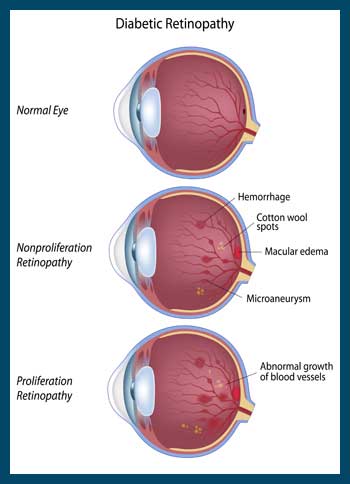Diabetic Retinopathy

The most common vascular disease affecting the retina are complications of diabetes and high blood pressure.
Diabetes
The most common cause of visual loss in people under the age of 60 in the United States is diabetes. Diabetes most often causes visual loss by causing leakage from the blood vessels in the macula, causing macular edema. This can be treated with intraocular steroid injections and/or laser treatment. Diabetes is divided into two stages, non-proliferative and proliferative disease. Macular edema can occur in either of these two stages. In non-proliferative diabetic retinopathy, there are small hemorrhages and exudates present. These are often not noticed by the patient. In the proliferative phase of diabetic retinopathy, new blood vessels grow from the retina anteriorly into the vitreous gel. This is a more serious phase of diabetic retinal disease as these blood vessels can cause significant bleeding within the eye, retinal detachment, and severe glaucoma. In addition usually once this stage is reached there is shutdown of normal vessels, which causes retinal ischemia, and can cause permanent visual loss.
Hypertension
Hypertension, often in combination with diabetes, can lead to the occlusion of major blood vessels supplying the retina. These occlusions, usually affect the retinal veins and are termed vein occlusions, and cause numerous intraretinal hemorrhages. Complications from this include retinal ischemia, macular edema, and the growth of abnormal new blood vessels, leading to intraocular bleeding, retinal detachment, and glaucoma.

